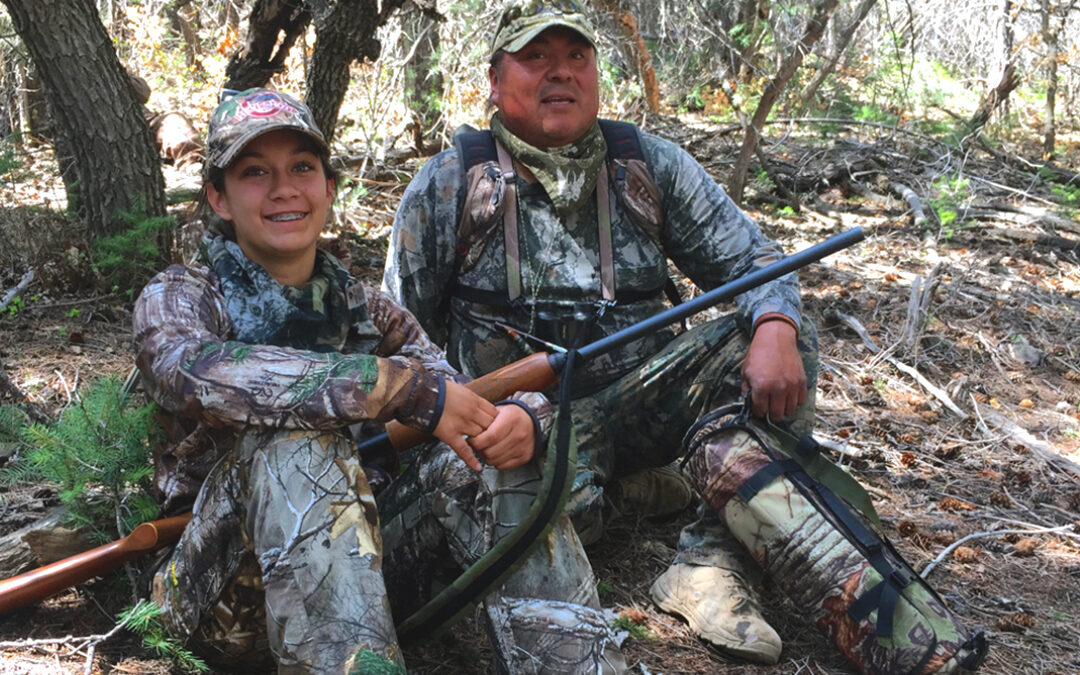That’s how the beautiful light feels falling on my teenage daughter, Willow. It’s bright enough that the bill of her camouflage cap casts a shadow over her eyes in this pre-dawn dark. The gleam travels from the sun, bounces off the moon, and lands on us to light up our way as we walk into the forest at 4:30 a.m.
We’re in the Manzano Mountains after Merriam’s turkey, a bird named for a famed zoologist. There’s just enough light to see the shimmer of Tajique Creek. We pass through a flat meadow with last summer’s brittle grasses the color of a deer’s pelt laid low by wind and a few deep winter snows. We slip into the inky shadows of tall ponderosa pines, fat with age, that exude an aroma akin to cream soda. An Emory oak that I cannot see rakes my face when I walk right into it as we move uphill. Careful to avoid cracking sticks with our steps, we move quietly along. The morning is about to come alive.

Willow listening attentively for a gobbler to announce his presence.
I’m among the first humans to walk into this forest—or so it feels. It’s primal, as though I’m sown in this steep hillside that takes extra breath to traverse. My daughter is the fit one, a high school sprinter and state-qualified pole vaulter; she eases right along. Being with her underscores the specialness of the time and place. She’s this age only once, and the time will come when turkey hunting with Dad will collide with others who desire her company as much as I do. Even worse, she’s my oldest daughter, and I’ll have to go through these feelings again with her sister.
Truth is, we are far from the first people to try and harvest the bounty of nature here. People have lived on the east flanks of the Manzanos for thousands of years. When U.S. Army topographer Lt. James Abert skirted these mountains in 1847, making a map for the newly arrived military, he was among the first English speakers to pass this way. The man noted the nature of the places, the wildlife, and the people—the towns of Chillli, Tajique, Manzano were occupied by folks who were newly minted American citizens, though not by their choice. Abert fantasized of Aztec architecture over the evidence of ancient earthworks from early Pueblo and Spanish occupation, structures that are now national historical monuments.
By my reckoning, the various people living in the Manzanos spoke at least three different languages dating back a few thousand years, Pueblo Indians among them. This morning we’re with our friend Gary Roybal from San Ildefonso Pueblo. In hunting turkey, Gary resurrects how the mountains of northern New Mexico have been used by Native peoples since about the time the wind began to blow. This is an ancient endeavor, and there’s a moral message to be discovered in harvesting your own local, free-range organic food.
Teddy Roosevelt harvested his own food. The bespectacled man was an ardent outdoorsman, a naturalist, and prodigious writer on all matters, including conservation. He once penned that as a young man he had fancied being a zoologist of the likes of Spencer Baird at the Smithsonian, or a bird guy like C. Hart Merriam.
In November 1906 when Roosevelt set aside by presidential proclamation the Manzano Forest Reserve, he in effect ensured that Merriam’s turkey habitat would be held in the public trust. The Manzano Forest Reserve was a short-lived name; “reserve” soon became “national forest.” In 1931, several forests in the middle of New Mexico were consolidated into today’s Cibola National Forest.

Gary working a bird with his own custom-made call.
As night melts into day, we’ve settled into an edge of a small glade in the cover of junipers near a ridge line. The woods are bathed in angular gold light that streams between openings in the trees. We listen intently for the tell-tale sounds of a tom. Gary clucks and whelps ever so softly on an assortment of calls that he artfully crafted from local native woods or a turkey bone from a bird he previously killed.
A plaintive whimper issued by two pieces of reddish alligator juniper rubbed together gets an immediate response. A tom heartily gobbles from down the ridge. Willow shoulders her 20 gauge, stock-still. Gary teases him with a few more light clucks and pulls him up the hill with his box call.
Seemingly out of nowhere a plump Merriam’s turkey appears on the edge of the opening. He’s puffed up, displaying his worthiness to the hen that he thinks is talking to him. His featherless neck looks like a shard of turquoise jewelry.
Fooling a tom turkey is not as easy as you might think. They are what Ben Franklin lore says Americans should be: wily and suspicious. Wild turkeys own the keenest sight and hearing. The slightest movement or unnatural sound will turn a tom away. This tom could not be moved further; after a few tantalizing minutes of watching him skirt us, he issued a pep-pep, wobbled a few steps, and melted ghost-like back into the ponderosas.
Being in the turkey woods requires forbearance of the elements, as well as understanding of bird behavior. Despite the accoutrements of modern firearms, camouflage clothing, and believable turkey calling, we are here on the animal’s terms. Advantage turkey.
Each outing brings more lessons learned about nature, forest ecology, and New Mexico history. Time with my friend Gary and my daughter, who is growing up way too fast, is time to be treasured. And the Manzanos—what a beautiful place be under the fuzzy morning moonlight.

